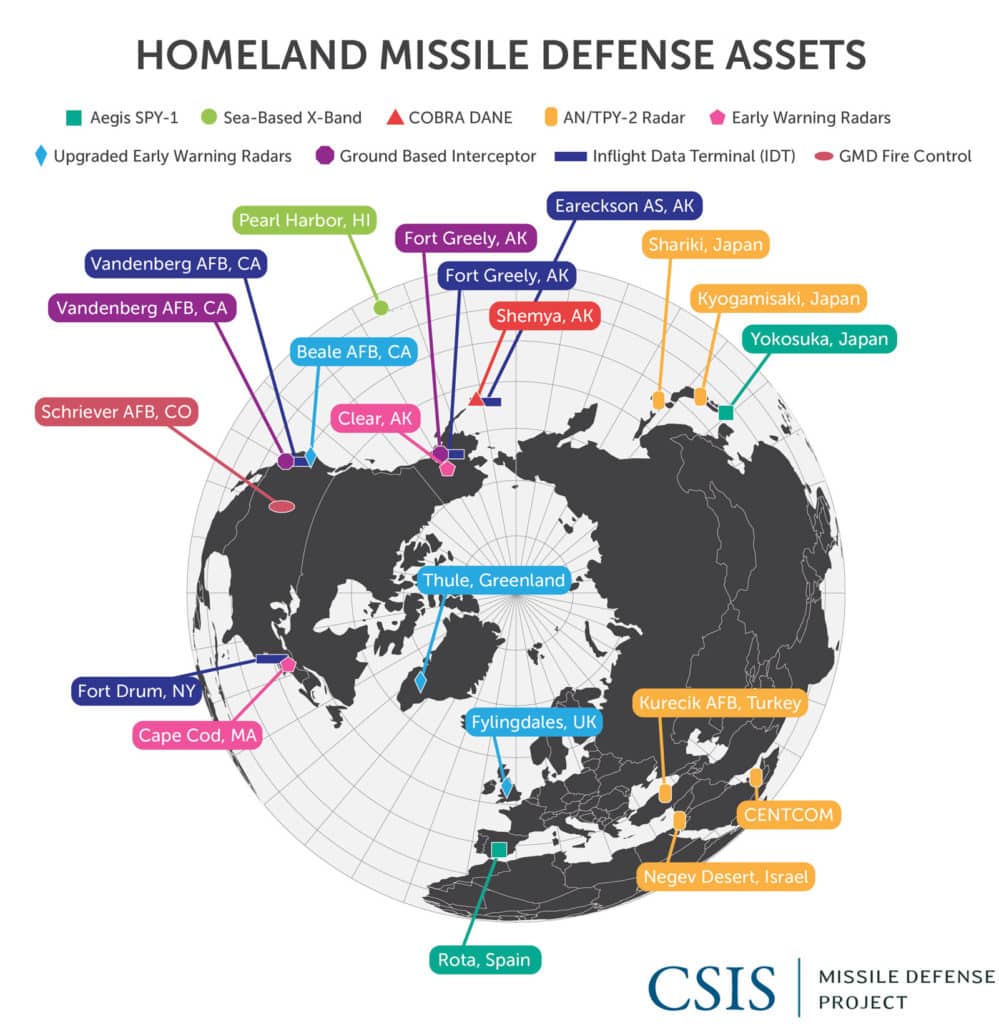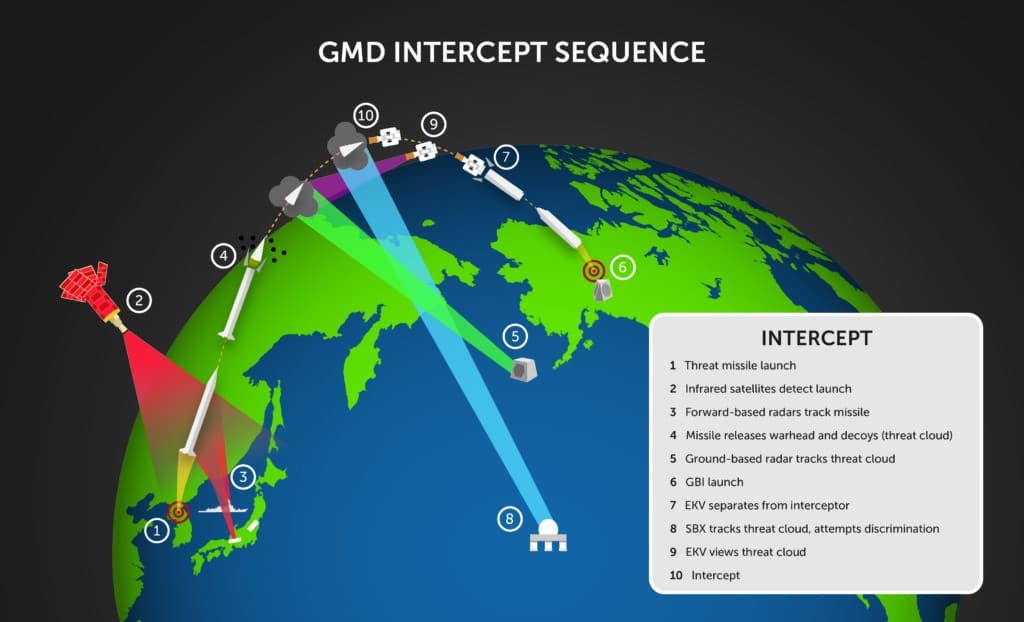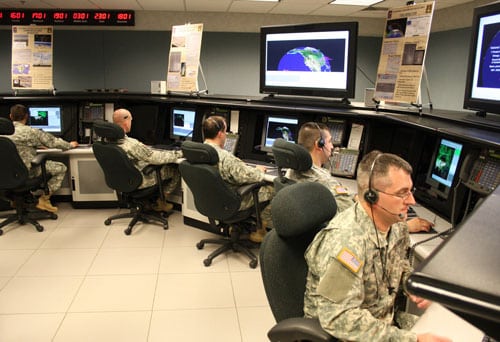System Elements
- AN/SPY-1 Radar
- AN/TPY-2 Radar
- Cobra Dane
- Command and Control, Battle Management, and Communications (C2BMC)
- Defense Support Program (DSP)
- Ground-based Interceptor (GBI)
- Long Range Discrimination Radar (LRDR)
- Sea-based X-band Radar (SBX)
- Space Tracking and Surveillance System (STSS)
- Space-based Infrared System (SBIRS)
- Upgraded Early Warning Radar (UEWR)
The Ground-based Midcourse Defense (GMD) is the United States’ homeland missile defense system, designed to protect all 50 states from a limited long-range ballistic missile attack. A global system, GMD and its associated elements span 15 time zones. These elements include Ground-based Interceptors (GBIs) at two locations: Ft. Greely, Alaska, and Vandenberg AFB, CA. GMD integrates data from seven types of sensors on land, sea, and space, networked together via distributed fire control and communication systems. As of 2021, there are 44 deployed GBIs, with 40 based at Ft. Greely and four at Vandenberg AFB.
How GMD Works
After detecting a missile launch, GMD’s ballistic missile defense sensors feed data into the GMD fire control system, which is used to launch one or more GBIs. Each three-stage, solid-fueled GBI flies into the path of the incoming missile before releasing an Exoatmospheric Kill Vehicle (EKV), which uses onboard sensors to track and physically collide with the warhead, destroying it on impact.

GMD is specifically designed to counter long-range ballistic missiles threatening the U.S. homeland. It uses a 1.27 m-diameter, three-stage booster, allowing it to intercept ballistic missiles at great distances. This range gives GMD by far the greatest coverage area of any U.S. missile defense system, defending all fifty states and Canada. Other missile defense systems, including Aegis, THAAD, and Patriot, are generally classified as “regional” systems, and are geared toward short- to intermediate-range ballistic missile threats. While the Aegis system has demonstrated limited homeland defense capabilities, it offers significantly smaller coverage against ICBMs compared to GMD.
Conversely, GMD is not capable of shorter-range, regional defense missions. For example, North Korea’s short and medium-range missiles—which threaten South Korea and Japan—fall outside of GMD’s engagement envelope. These threats require other missile defenses for intercept missions, such as Aegis, THAAD, or Patriot.
GMD Development
The GMD architecture emerged as a development of the Clinton Administration’s National Missile Defense (NMD) program. The Ballistic Missile Defense Organization (BMDO) formed the initial Joint Program Office for the NMD program in April 1997, with the goal of conducting an integrated test in 1999 and operational deployment by 2003.1 The BMDO began flight testing Ground-based interceptors in 1997 and achieved its first successful intercept in 1999.
In 1998, the Congressionally-chartered Rumsfeld Commission reported that the United States had underestimated the ballistic missile threat. This assessment provided impetus for Congress to pass the 1999 National Missile Defense Act, which committed the United States “to deploy as soon as is technologically possible an effective National Missile Defense system capable of defending the territory of the United States against limited ballistic missile attack.”2 While continuing development of the NMD system, the Clinton administration deferred the decision to deploy homeland missile defense to the next administration.

In December 2001, the George W. Bush Administration announced that it would withdraw the United States from the 1972 Anti-Ballistic Missile Treaty, opening the door to deploying a homeland missile defense system. In January 2002, then-Secretary of State Donald Rumsfeld redesignated the BMDO as the Missile Defense Agency (MDA). Later that year, the White House issued National Security Presidential Directive 23 (NSPD-23), ordering the deployment of an initial limited homeland defense capability by 2004. In 2004, Lt. Gen. Henry “Trey” Obering, III, USAF, the Director of MDA, declared that GMD had reached “limited defensive operations” with five GBIs emplaced at Fort Greely, Alaska; an upgraded Cobra Dane Radar at Eareckson Air Station in Shemya, Alaska; and an upgraded radar at Fylingdales in the United Kingdom.
In its initial formulation, the GMD system was intended to grow to 44 GBIs distributed between Fort Greely and Vandenberg Air Force Base.3 The Bush Administration later proposed a European GMD site to counter the future development of an Iranian ICBM. This component of the GMD system would have included an additional ten GBIs in Poland and an X-band radar in the Czech Republic.4
The Obama Administration later cancelled the proposed European GMD sites in favor of the Aegis-based European Phased Adaptive Approach.5 The administration also capped the planned GBI deployments to 30, a reduction from the 44 planned under Bush.6
In 2013, then-Defense Secretary Chuck Hagel announced a reversal of the decision to reduce the U.S. based interceptors and reconstituted a plan to deploy 44 GBIs by 2017.7 The Missile Defense Agency installed its 44th GBI at Fort Greely, Alaska in November 2017.
GMD Fire Control and Communication
GMD Fire Control and Communication (GFC) is the software that is used to manage the Ground-based Midcourse Defense system. The system receives data from various sensors across the globe via the Defense Satellite Communication System, and compiles this information to create picture of the battlespace. It updates the warfighter on the status of the GBI fleet, which facilitates engagement planning and launch decisions. After a GBI launch, the GFC also relays real time in-flight targeting data via one of the six operational In-Flight Data Terminals to the exo-atmospheric kill vehicle. GMD Fire Control is also configured to receive information via C2BMC, which allows sensors such as Aegis’ SPY-1 and THAAD’s TPY-2 to contribute to the homeland defense mission.8

GFC 7A intends to improve the ability of the system to switch between redundant systems and replace the aging Command Launch Equipment, modernizing and streamlining the GFC architecture. The 7B system will include the capability for two and three-stage selectable boosters, additional discrimination upgrades, new nuclear weapons effects planning software, and upgraded communications for the Redesigned Kill Vehicle.9
Ongoing Programs
The Missile Defense Agency has continued to upgrade the GMD system with new sensors, interceptors, and fire control systems. The following programs are in development, under consideration, or have been studied.
East Coast Site
The 2015 National Defense Authorization Act (NDAA) authorized funds to review a potential third launch site on the East Coast for the GMD system. In June 2019, the U.S. Defense Department told Congress that Fort Drum, NY is their preferred location for an east coast site, but noted that since there remains “no operational requirement for an East Coast CIS, the Department has no intent to develop one.”10
Alaska Long Range Discrimination Radar (LRDR)
In 2015, the Obama administration awarded a contract to build a new long-range radar, the Long Range Discrimination Radar (LRDR), at Clear Air Force Station in Alaska. Operating in the S-band, LRDR is intended to improve GMD’s ability to discriminate missile warheads from decoys and other debris.11 Following a pandemic-related work stoppage, MDA completed installation of LRDR’s antenna arrays in November 2020.12 LRDR tracking tests have been pushed back to late FY 2022.13 The USAF is expected to take ownership of the Alaska LRDR in late FY 2023.14
Homeland Defense Radar-Hawaii
In December 2018, the U.S. Missile Defense Agency awarded a $585 million contract to begin development of the Homeland Defense Radar-Hawaii (HDR-H). According to the contract, the radar will provide “autonomous acquisition and persistent precision tracking and discrimination to optimize the defensive capability of the Ballistic Missile Defense System (BMDS) and counter evolving threats.”15 The deal was finalized following regular North Korean missile testing.
Next Generation Interceptor (NGI)
In April 2020, the U.S. Defense Department issued a Request For Proposal (RFP) for the Next Generation Interceptor (NGI), a new interceptor for the GMD System that will replace GBIs.16 The Pentagon had previously circulated a classified draft NGI RFP to industry in August 2019. The NGI program is expected to cost around $11 billion to field 20 interceptors, with testing expected for 2025-26 and deployment expected for 2027-28.
Footnotes
- DefenseLINK News, “BMDO Forms New Joint Program Office,” DefenseLINK, April 3, 1997, http://osd.dtic.mil/news/Apr1997/m040397_m049-97.html.
- “An Act To Declare it to be the Policy of the United States to Deploy a National Missile Defense,” Public Law 106-38, (106) July 22, 1999, https://www.congress.gov/106/plaws/publ38/PLAW-106publ38.pdf.
- Ibid
- Thom Shankar and Nicholas Kulish, “U.S. and Poland Set Missile Deal,” New York Times, August 14, 2008, http://www.nytimes.com/2008/08/15/world/europe/15poland.html.
- Peter Baker, “White House Scraps Bush’s Approach to Missile Shield,” The New York Times, September 17, 2009, http://www.nytimes.com/2009/09/18/world/europe/18shield.html.
- Jennifer Giffin, “Lawmakers Question Obama’s Missile Defense Cuts,” Fox News, June 16, 2009, http://www.foxnews.com/politics/2009/06/16/lawmakers-question-obamas-missile-defense-cuts.html.
- Thom Shanker, David E. Sanger, and Martin Fackler, “U.S. Is Bolstering Missile Defense to Deter North Korea,” The New York Times, March 15, 2013, http://www.nytimes.com/2013/03/16/world/asia/us-to-bolster-missile-defense-against-north-korea.html.
- “Ground-based Midcourse Defense (GMD) Program Overview,” Missile Defense Agency, May 24, 2016, 13, https://www.mda.mil/global/documents/pdf/osbp_16conf_GMD_Next_Follow_On_Barrow.pdf.
- Ibid, 15.
- Scott Atkinson, “Fort Drum picked as site for east coast missile defense,” 7 News WNYTV, June 26, 2019, https://www.wwnytv.com/2019/06/27/fort-drum-picked-site-east-coast-missile-defense/.
- Mike Gruss, “Lockheed Martin Lands Missile Defense Radar Contract,” Space News, October 22, 2015, http://spacenews.com/lockheed-martin-lands-missile-defense-radar-contract/#sthash.Y1wP2BlK.dpuf.
- U.S. Congress, Senate, Subcommittee on Strategic Forces, Missile defense strategy, policies, and programs in review of the Defense Authorization Request for fiscal year 2022 and the Future Years Defense Program, (Testimony of Jon A. Hill) 117th Cong., 2nd sess., (June 9, 2021), https://www.armed-services.senate.gov/imo/media/doc/Hill%20Written%20Statement%20to%20SASC%206-09.pdf.
- Jen Judson, “Yearlong delay hits operational test of Alaska-based missile defense radar,” Defense News, April 30, 2021, https://www.defensenews.com/air/2021/04/30/alaska-based-missile-defense-radar-operational-test-delayed-a-year/.
- Ibid.
- David Larter, “Lockheed Martin scores a big win in new Missile Defense Agency radar contract,” Defense News, December 18, 2018, https://www.defensenews.com/land/2018/12/18/lockheed-martin-scores-a-big-win-in-new-radar-missile-defense-agency-radar-contract/.
- Masao Dahlgren, “US Solicits Proposals for Next Generation Interceptor,” Missile Threat, Center for Strategic and International Studies, April 27, 2020, last modified April 27, 2020, https://missilethreat.csis.org/us-solicits-proposals-for-next-generation-interceptor/.